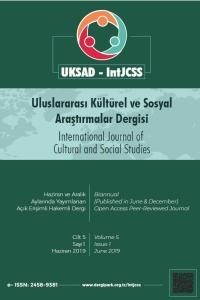Anthropometric Profile, Wingate Performance and Special Judo Fitness Levels of Turkish Cadet Judo Athletes
Judo, Special Judo Fitness Test, Cadet Athletes, Performance,
___
- Arazi H., Noori M., Izadi M. (2017), Correlation Of Anthropometric And Bio-Motor Attributes With Special Judo Fitness Test In Senior Male Judoka, " IDO Movement For Culture. Journal Of Martial Arts Anthropology", Vol. 17, No.4, Pp. 19-24.
- Callister R., Callister R.J., Staron R.S., Fleck S.J., Tesch P., Dudley G.A. (1991), Physiological Characteristics Of Elite Judo Athletes, "International Journal Of Sports Medicine", Vol. 12, Pp. 196–203.
- Casals C., Huertas J.R., Franchini E., Sterkowicz-Przybycien K., Sterkowicz S., Gutierrez-Garcia C., Escobar-Molina R. (2017), Special Judo Fitness Test Levelandanthropometricprofile Of Elite Spanish Judo Athletes, "Journal Of Strength And Conditioning Research", Vol. 31, No. 5, Pp. 1229-1235; Doi: 10.1055/S-2007-1024667.
- Ceylan, B., & Balcı, Ş. S. (2017). The Impact Of New Rule Changes In Judo: A Comparison Of Points And Penalties During Grand Slam Paris Between 2016 And 2017. Journal Home Page , 2(3), 91-94.
- Ceylan, B., & Balcı, Ş. S. (2017). The Relationship Between Body Composition And Some Performance Variables In Cadet Judo Athletes. Acta Medica Marisiensis, 63.
- Detanico, D., Dal Pupo, J., Franchini, E., & Dos Santos, S. G. (2012). Relationship Of Aerobic And Neuromuscular Indexes With Specific Actions In Judo. Science & Sports, 27(1), 16-22.
- Drid P., Trivic T., Tabakov S. (2012), Special Judo Fitness Test- A Review, "Serbian Journal Of Sports Science", Vol. 6, Pp. 117-125.
- Franchini E., Nunes A.V., Moraes J.M., Del Vecchio F.B. (2007), Physical Fitness And Anthropometrical Profile Of Brazilian Male Judo Team, "Journal Of Physiological Anthropoly",Vol. 26, No. 2, Pp. 59-67; Doi: 10.2114/Jpa2.26.59.
- Franchini E., Takito M.Y., Bertuzzi R.C.M. (2005a), Morphological, Physiological And Technical Variables In High-Level College Judoists, "Archives Of Budo", Vol. 1, Pp. 1-7.
- Franchini E., Vecchio F.B.D., Sterkowicz S. (2009), A Special Judo Fitness Test Classificatory Table. "Archives Of Budo", Vol. 5: 127-129.
- Franchini, E., Nunes, A. V., Moraes, J. M., & Del Vecchio, F. B. (2007). Physical Fitness And Anthropometrical Profile Of The Brazilian Male Judo Team. Journal Of Physiological Anthropology, 26(2), 59-67.
- Franchini, E., Rodríguez Huertas, J., Sterkowicz, S., Carratalá, V., Gutiérrez-García, C., & Escobar-Molina, R. (2011). Anthropometrical Profile Of Elite Spanish Judoka: Comparative Analysis Among Ages. http://Www.Sportsci.Org/Resource/Stats/Index.Html (Access May 2018)
- Kim J., Cho H.C., Jung H.S., Yoon J.D. (2011), Influence Of Performancelevel On Anaerobic Power And Body Composition In Elite Male Judoists, "Journal Of Strength And Conditioning Research", Vol. 25, No. 5, Pp. 1346-1345; Doi: 10.1519/JSC.0b013e 3181d6d97c.
- Kubo J., Chishaki T., Nakamura N., Muramatsu T., Yamamoto Y., Ito M., Saitou H., Kukidome T. (2016), Differences In Fat-Free Mass And Muscle Thicknesses At Various Sites According To Performance Level Among Judo Athletes, "Journal Of Strength And Conditioning Research", Vol. 20, No. 3, Pp. 654–657; Doi: 10.1519/R-17054.1
- Sterkowicz, S., Zuchowicz, A., & Kubica, R. (1999). Levels Of Anaerobic And Aerobic Capacity Indices And Results For The Special Fitness Test In Judo Competitors. Journal Of Human Kinetics, 2(1), 115-135.
- Sterkowicz-Przybycień K., Fukuda D.H., Franchini E., Sterkowicz S. (2016), Special Judo Fitness Test: Results And Applications. "Science And Medicine In Combat Sports" (NY): Nova Publishers; Pp. 145-173.
- Torres-Luque, G., Hernandez-Garcia, R., Garatachea, N., & Nikolaidis, P. T. (2015). Anthropometric Characteristics And Neuromuscular Function In Young Judo Athletes By Sex, Age And Weight Category. Sport Sciences For Health, 11(1), 117-124.
- Başlangıç: 2015
- Yayıncı: Mutlu TÜRKMEN
İ. Ayşad GÜDEKLİ, Nur CEMELELİOĞLU ALTIN
Duygulara Tepki Veren Akıllı Moda Tasarımları
İslâm Öncesinden Sonrasına Türk Geleneğinde Bir Yaşam Stili:“Okçuluk”
Okan GÜLTEKİN, Fahriye Esra BAŞYİĞİT
Veli Volkan GÜRSES, Mustafa Şakir AKGÜL, Bayram CEYLAN, Bilgehan BAYDİL, Şükrü Serdar BALCI
Moda Tasarımcılarının Takı Tasarımı Yaklaşımları
Nuriye İŞGÖREN, Çimen BAYBURTLU, Demet ÖZNAZ, Gülhan ACAR BÜYÜKPEHLİVAN
